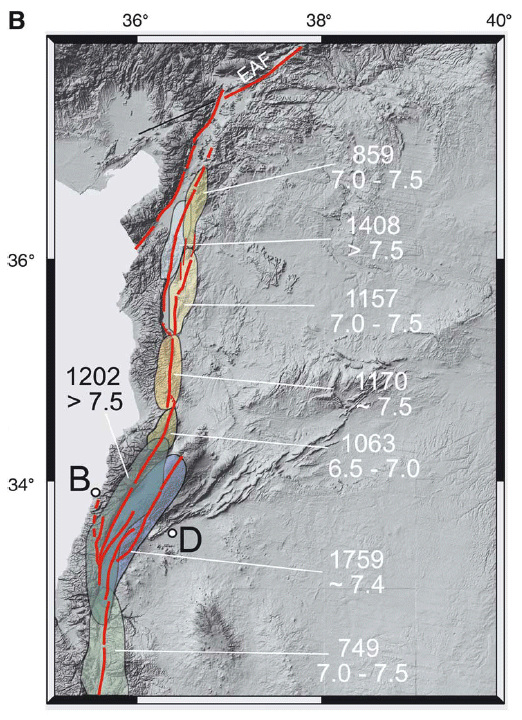
The long historical record of earthquakes, the physical effects on ancient
building structures and the palaeoseismology provide a unique opportunity for
an interdisciplinary tectonic analysis along a major plate
boundary and a realistic evaluation of the seismic hazard assessment in the
Middle East. We demonstrate with microtopographic surveys and trenching that
the Dead Sea fault (DSF) offsets left-laterally by 13.690.2 m a repeatedly fractured
ancient Roman aqueduct (older than AD 70 and younger than AD 30). Carbon-14
dating of faulted young alluvial deposits documents the occurrence of three
large earthquakes in the past 2000 years between AD 100 and 750, between AD
700 and 1030 and between AD 990 and 1210. Our study provides the timing of late
Holocene earthquakes and constrains the 6.990.1 mm/yr slip rate of the Dead
Sea transform fault in northwestern Syria along the Missyaf segment. The antepenultimate
and most recent faulting events may be correlated with the AD 115 and AD 1170
large earthquakes for which we estimate Mw =7.3^7.5. The 830 yr of seismic quiescence
along the Missyaf fault segment implies that a large earthquake is overdue and
may result in a major catastrophe to the population centres of Syria and Lebanon.
Click here to view a PDF of the post-print
This paper was published in Earth and Planetary Science Letters by Elsevier Science. Elsevier Science retains the copyright to this paper.
Figure 1b. Map of fault segments interpreted from structural pattern along the northern section of the DSF and inferred ruptures of the main historical seismic events (see also Table 1) [1,4,6,17]; B is Beirut and D is Damascus. The historical seismicity that documents the sequence of AD 1157, 1170 and 1202 large events is based on original Arabic sources [4^6,24]; their spatial distribution suggests a structural control of coseismic ruptures associated with a fault segmentation along the DSF.
